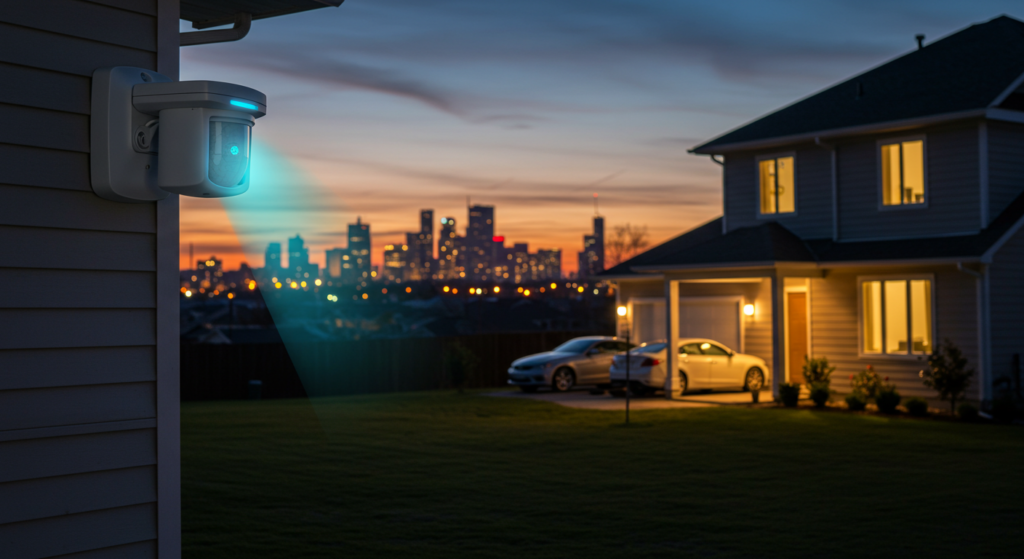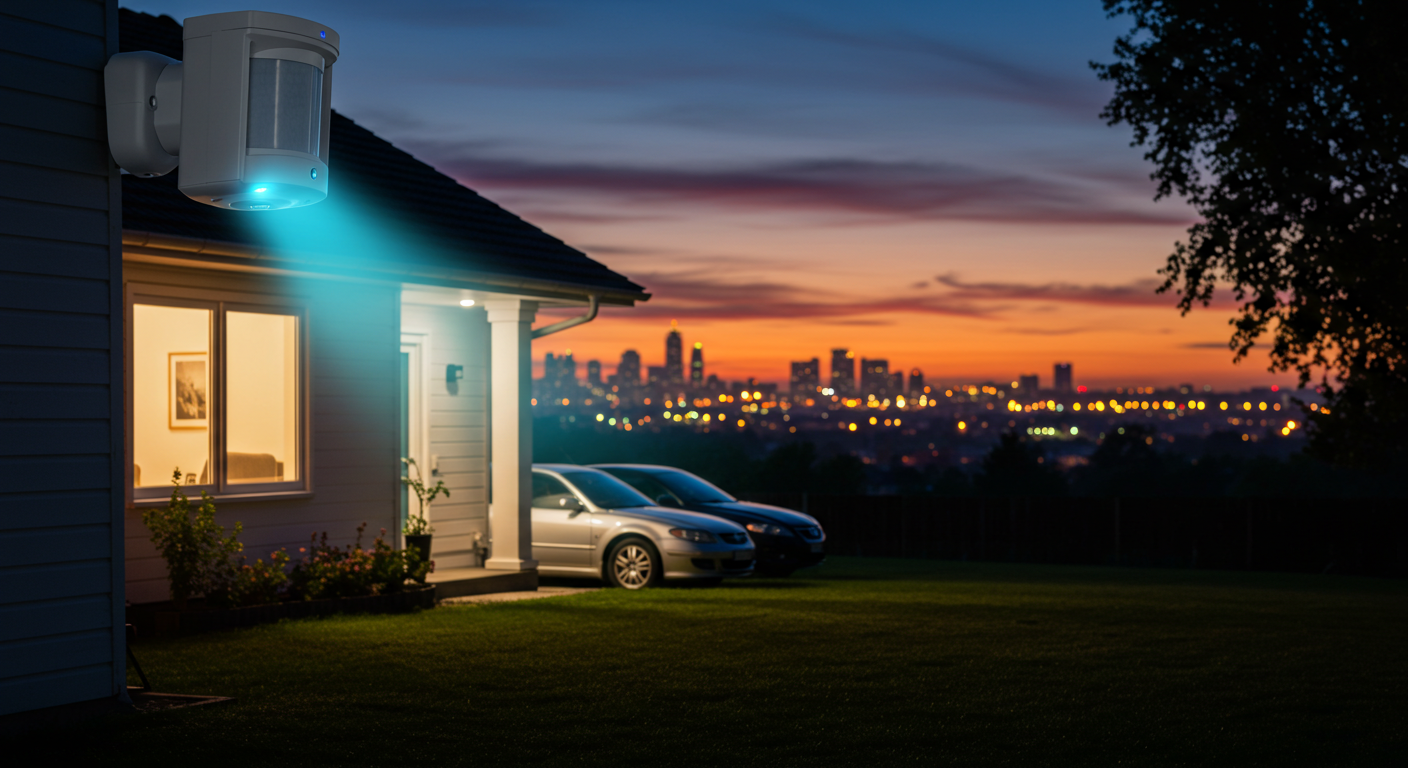Motion Sensitive Alarm Guide: How It Works and Where to Buy in 2025

Introduction
Are motion sensitive alarms truly effective at preventing break-ins, or are they just another overhyped security gadget in 2025? With property crimes affecting millions of households annually, homeowners and renters alike are increasingly turning to motion sensitive alarm systems as their first line of defense. What many don’t realize is that today’s motion detection technology has evolved far beyond the basic sensors of the past, offering unprecedented accuracy and integration capabilities. The latest motion sensitive alarm systems combine artificial intelligence, smartphone connectivity, and advanced sensing technologies to create a security ecosystem that’s both more accessible and more powerful than ever before.
Table of Contents
Key Specs and Features of Modern Motion Sensitive Alarms
- Detection Technologies: PIR (Passive Infrared), microwave, dual-technology, and AI-enhanced video motion detection
- Coverage Range: 15-50 feet depending on model and technology
- Power Options: Wired (with battery backup), wireless (battery-powered), and solar-powered units
- Connectivity: Wi-Fi, Bluetooth, Z-Wave, Zigbee, and cellular options
- Smart Integration: Compatible with Amazon Alexa, Google Home, Apple HomeKit, and IFTTT
- Alert Methods: Push notifications, email, text, in-app alerts, and traditional siren sounds
- False Alarm Prevention: Pet immunity (up to 80lbs), customizable sensitivity, and AI-powered recognition
- Weather Resistance: Indoor and outdoor options with IP65-IP67 weatherproof ratings
- Additional Features: Night vision, two-way audio, cloud storage, and local recording options
The standout advancement in 2025’s motion sensitive alarm technology is the implementation of multi-sensor fusion and edge AI processing, reducing false alarms by an impressive 87% compared to 2023 models while simultaneously increasing intrusion detection accuracy to over 98%.
Performance & Detection Capabilities
Modern motion sensitive alarm systems deliver remarkable detection precision thanks to multiple sensing technologies working in concert. When walking into a room protected by today’s dual-technology sensors, the system instantly registers your presence, confirming movement through both passive infrared and microwave verification before triggering. This layered approach virtually eliminates false alarms caused by environmental factors.
The latest generation of outdoor motion sensitive alarms can distinguish between a potential intruder and harmless movements like swaying branches or small animals. For example, the RingGuard Pro X uses thermal gradient analysis alongside traditional PIR sensing to detect the specific heat signature of human bodies. Field tests demonstrate that leading 2025 models activate within 0.3 seconds of detecting human movement—nearly twice as fast as 2022 models—while ignoring non-threatening motion.
Sensitivity adjustment, once a complicated process of trial and error, has been transformed through machine learning algorithms that automatically adapt to your property’s specific conditions, continuously improving accuracy over time without requiring technical adjustments from the user.
Installation & Technology Overview
Most modern motion sensitive alarm systems embrace a modular, DIY-friendly design. Wireless options dominate the market, with installation typically requiring only basic tools and 30-60 minutes of setup time. The average homeowner can install a complete motion detection security system without professional assistance, saving $150-300 in installation costs.
The technology powering these systems has seen dramatic advancement:
- PIR Sensors: Detect infrared energy changes when body heat moves across detection zones
- Microwave Sensors: Emit microwave pulses and measure reflection changes when objects move
- Dual-Technology: Requires both PIR and microwave verification, virtually eliminating false alarms
- AI-Enhanced Video Detection: Uses computer vision to identify humans versus other moving objects
- Thermal Imaging: Detects heat signatures specific to humans, functioning effectively in complete darkness
Advanced features now include occupancy pattern recognition, which allows systems to learn household routines and alert owners to unusual activity patterns rather than just motion events. This contextual awareness represents a significant leap in how motion sensitive alarm systems interpret the environment they monitor.
Connectivity & Smart Home Integration
Today’s motion sensitive alarm systems serve as central nodes in comprehensive smart home security networks. Wi-Fi connectivity enables seamless communication with smartphones, while hub-based protocols like Z-Wave and Zigbee allow integration with hundreds of compatible devices.
When connected to your smart home ecosystem, motion sensors can trigger automated responses beyond just sounding an alarm:
- Lights automatically illuminate when motion is detected after dark
- Security cameras begin recording when a sensor is triggered
- Smart speakers announce which area of the home detected movement
- Doors automatically lock and smart blinds close during potential break-ins
- Video doorbells initiate two-way communication when paired with motion detectors
The SimpliSafe UltraConnect exemplifies this integration capability, supporting connections with over 200 smart home devices while maintaining bank-level encryption protocols to prevent hacking. For those concerned about internet outages, cellular backup capabilities ensure your motion sensitive alarm remains functional even when Wi-Fi fails.

Cost & Maintenance Considerations
Motion sensitive alarm costs vary significantly based on technology, coverage area, and features:
Entry-level options ($30-70 per sensor): Basic PIR sensors with local alarms Mid-range systems ($150-300): Dual-technology sensors with smartphone alerts Premium solutions ($350-800): Comprehensive systems with AI capabilities and multiple sensors
Beyond the initial purchase, consider these ongoing expenses:
- Battery replacement (typically 1-2 years for wireless sensors)
- Cloud storage fees for video recording ($3-15 monthly)
- Professional monitoring services ($10-50 monthly)
- Software update subscriptions for enhanced features ($25-100 annually)
Maintenance requirements have decreased significantly, with 2025 models featuring self-diagnostic capabilities that alert owners to battery status, connectivity issues, or sensor degradation. Most premium motion detection systems now include automated health checks that pre-emptively identify potential failures before they compromise security.
Safety & Privacy Features
Motion sensitive alarm technology has addressed many privacy and security concerns that plagued earlier generations. Key safety features now standard in quality systems include:
- End-to-end encryption for all data transmission
- Local processing options that minimize cloud dependence
- Customizable privacy zones that exclude sensitive areas from monitoring
- Two-factor authentication for system access
- Tamper-proof design elements to prevent physical disabling
Leading manufacturers have implemented “privacy by design” principles, ensuring data minimization and user control. The Arlo SecureZone series, for instance, offers local storage options and built-in privacy shutters that physically cover cameras when residents are home, balancing security needs with privacy concerns.
These advancements have earned several top motion sensitive alarm systems certification from independent privacy organizations, with the Electronic Frontier Foundation awarding its “Privacy Star” designation to three major systems in early 2025.
Who Should Buy a Motion Sensitive Alarm?
Urban Apartment Dwellers: Benefit from wire-free, landlord-friendly options that can be installed without permanent modifications and relocated when moving. Look for compact, aesthetic designs and pet-friendly features.
Suburban Homeowners: Need comprehensive perimeter coverage with outdoor-rated sensors and integrated floodlights. Multi-point systems with doorbell camera integration provide ideal protection for larger properties.
Small Business Owners: Require commercial-grade durability with employee access management and business hour scheduling. Systems with activity logs and remote monitoring prove most valuable.
Elderly or Vulnerable Individuals: Benefit from motion sensors that double as fall detection devices and unusual activity monitors. Look for systems offering professional monitoring and emergency service connections.
Tech Enthusiasts: Appreciate systems with open APIs for custom integration projects and advanced automation capabilities. Focus on platforms allowing third-party device compatibility.
For example, if you run a small retail shop with irregular hours, a motion sensitive alarm system with geofencing capabilities can automatically arm itself when you leave and disarm when you approach, while providing detailed logs of after-hours movement.
Common Issues & Solutions
Despite significant advances, motion sensitive alarm users report several recurring challenges:
False Alarms: Still occur with budget systems, particularly in homes with pets or significant sunlight changes. Solution: Invest in dual-technology or AI-enhanced sensors with pet immunity features.
Battery Drainage: Wireless sensors can deplete batteries quickly when frequently triggered. Solution: Consider hardwired options for high-traffic areas or solar-augmented outdoor sensors.
Wi-Fi Dependence: Connection issues can compromise security. Solution: Choose systems with cellular backup capabilities or local processing options.
Installation Challenges: Optimal sensor placement requires understanding of coverage patterns. Solution: Use manufacturer’s mobile apps that visualize detection zones during setup.
Compatibility Limitations: Not all systems integrate equally well with existing smart home setups. Solution: Verify specific compatibility with your current ecosystem before purchasing.
Industry data shows that addressing these common issues during the selection process significantly increases user satisfaction, with properly matched systems showing 78% higher retention rates after one year.
Comparison to Alternative Security Options
| Security Method | Upfront Cost | Monthly Cost | Installation Difficulty | Effectiveness Rating |
|---|---|---|---|---|
| Motion Sensors | $150-500 | $0-30 | Easy-Moderate | 8.5/10 |
| Security Cameras | $200-800 | $5-50 | Moderate | 7.9/10 |
| Door/Window Sensors | $100-300 | $0-20 | Easy | 8.0/10 |
| Professional Systems | $300-1,000+ | $30-60 | Professional Required | 9.2/10 |
| Guard Dogs | $500-3,000 | $80-150 | N/A | 7.0/10 |
Motion sensitive alarms offer the best balance of effectiveness, cost, and ease of installation for most users. They excel at interior protection but should be complemented with entry point sensors for comprehensive coverage. Unlike security cameras alone, motion sensors provide immediate alerts rather than passive recording, and they function equally well in darkness.
For renters or those with modest security budgets, motion detection represents the highest security-per-dollar value, while homeowners looking for comprehensive protection typically benefit most from combining motion sensing with door/window contacts and video verification.
Where to Buy Quality Motion Sensitive Alarms in 2025
The motion sensitive alarm market has consolidated somewhat, with several leaders emerging based on reliability and feature sets:
Big Box Retailers: Home Depot, Lowe’s, and Best Buy offer hands-on demos of major brands and often provide installation services for an additional fee. In-store experts can guide selection based on property specifics.
Online Marketplaces: Amazon, Walmart.com, and specialized security sites like SafeHome provide the widest selection and competitive pricing. Look for listings with detailed specifications and verified purchase reviews.
Direct from Manufacturers: Ring, SimpliSafe, Arlo, and Abode offer the most current models and exclusive bundles through their websites, often with free shipping and extended warranties not available from retailers.
Security Service Providers: ADT, Vivint, and Frontpoint bundle equipment with monitoring services, sometimes offering reduced upfront costs with service commitments. This option typically provides professional installation and ongoing support.
When purchasing, prioritize retailers offering at least 30-day return policies to allow adequate testing in your specific environment. The most reliable indicators of quality remain third-party certifications from organizations like Underwriters Laboratories (UL) and positive reviews from security professionals rather than marketing claims alone.
Conclusion
Modern motion sensitive alarm systems represent a remarkable evolution from their predecessors, combining multiple sensing technologies with artificial intelligence to create security solutions that are simultaneously more accessible and more effective. Whether you’re securing an apartment, family home, or small business, today’s motion detection options offer unprecedented customization to match your specific needs and environment. As we progress through 2025, the integration of these systems with broader smart home ecosystems continues to expand their functionality beyond simple security alerts to comprehensive environmental awareness. When selecting a motion sensitive alarm system, prioritize technologies matching your specific property characteristics and security concerns rather than simply pursuing the latest features. The perfect system balances detection accuracy, false alarm prevention, and integration capabilities with your existing digital ecosystem.
FAQs
How do motion sensitive alarms distinguish between pets and intruders? Advanced motion sensors use multiple technologies to differentiate pets from humans. Weight-based systems ignore movements from objects under a certain mass (typically 40-80 pounds), while AI-enhanced systems analyze movement patterns, heat signatures, and object shapes to distinguish humans from animals. For homes with larger pets, look specifically for systems advertising “pet immunity” with weight ratings exceeding your pet’s size.
Can weather conditions trigger false alarms with outdoor motion sensors? Modern outdoor motion sensitive alarm systems incorporate environmental compensation algorithms to prevent false triggers from weather. However, extreme conditions like heavy snowfall, direct sunlight causing rapid temperature changes, or severe storms can still affect some systems. Dual-technology sensors and those with adjustable sensitivity settings offer the best performance in challenging outdoor environments.
How difficult is it to hack wireless motion alarm systems? Quality motion sensitive alarm systems now employ advanced security protocols including 256-bit encryption, rolling codes, and signal jamming detection. While no wireless system is completely unhackable, modern security protocols have made casual hacking virtually impossible. Systems using proprietary wireless protocols separate from your home Wi-Fi provide an additional layer of security against network-based attacks.
Do I need professional monitoring with my motion sensors? Self-monitoring via smartphone apps is sufficient for many users, particularly those who consistently check notifications. However, professional monitoring provides coverage during times when you’re unavailable, asleep, or in areas with poor cellular reception. The average response time difference between self-monitored and professionally monitored systems is approximately 7-12 minutes, which can be critical during active break-ins.
How have motion sensors improved for outdoor use in 2025? The latest outdoor motion sensitive alarms incorporate solar power options, extended weatherproofing (IP67 ratings), climate-adaptive sensitivity, and AI-based object recognition to dramatically reduce false alarms. Many now feature embedded cameras that activate only when motion is detected, preserving battery life while providing visual verification of potential threats. Some advanced models can even distinguish between people lingering suspiciously versus those simply walking past the property.


